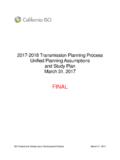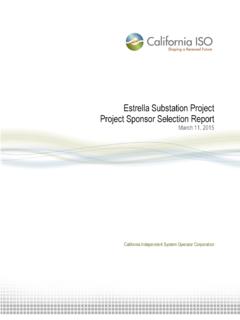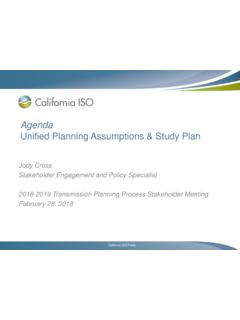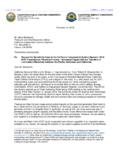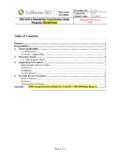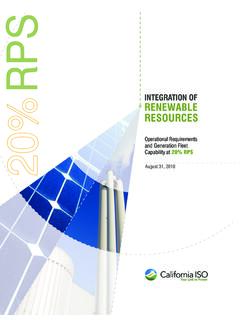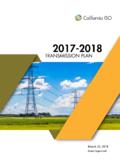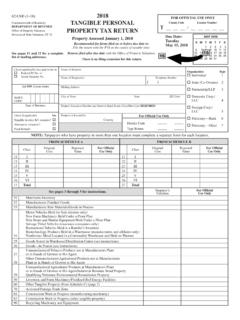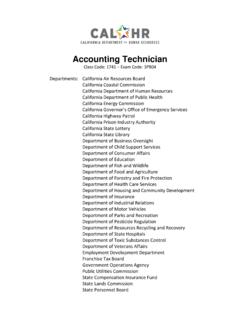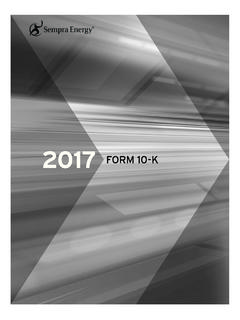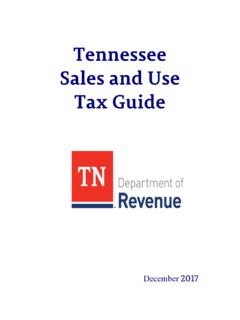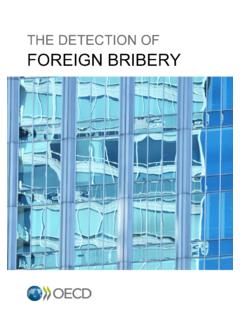Transcription of 2018 Budget and Grid Management Charge Rates
1 2018 Budget and grid Management Charge Rates October 2017. DRAFT. Prepared by the Financial Planning and Procurement department California Independent System Operator Corporation Table of Contents I. 2018 Revenue Requirement 3 Components of 208 Revenue Requirement .. 4 II. Budget Overview 5 Budget Guidance .. 6 Strategic Outlook .. 7 Aligning with the ISO's Strategic Plan .. 7 III. Process View 9 Plan and Manage Business .. 11 Support Business Services .. 11 Manage Human Capabilities .. 12 Develop Markets and Infrastructure .. 12 Operate Markets and grid .. 13 Support Customers and 14 IV. ISO Resource Utilization 16 Salaries and 16 Occupancy Costs and Equipment .. 19 Telecommunications and Hardware and Software Maintenance 20 Consultants and Contract Staff .. 21 Outsourced Contracts and Professional Fees .. 22 Training, Travel and Other Costs .. 23 Reconciliation of 2018 O&M Budget .. 24 V. ISO Divisional Budget Overviews 25 Chief Executive Officer Division .. 26 Market and Infrastructure Development Division.
2 28 Technology Division .. 30 Operations Division .. 33 General Counsel and Chief Compliance Officer Division .. 36 Market Quality and Renewable Integration Division .. 38 Customer and State Affairs Division .. 40 Regional and Federal Affairs Division .. 42 VI. Debt Service 44 VII. Capital / Project Budget and Cash-Funded Capital 46 Supplemental Board Approved Projects .. 46 Capital / Project Budget Development Process .. 46 Proposed Project List .. 47 VIII. Other Costs and Revenue 51 IX. Operating Cost Reserve Adjustment 52 X. grid Management Charge Calculations 53 Components of GMC and Billing Determinants .. 54 Rate Calculation .. 54 Summary of GMC Costs and Rates .. 56 CEO/Treasury/FPP Page 2. I. 2018 R E V E N U E R E Q U I R E M E N T. The 2018 Budget results in a revenue requirement of $ million, which represents a 1% increase over 2017. Fiscal discipline remains a priority for the California Independent System Operator Corporation as evidenced by the continued stability of the revenue requirement.
3 Since 2007, the revenue requirement has averaged an annual increase of less than 1% and remains 17% lower than the peak in 2003. The ISO has absorbed several major initiatives during this time with no material impact to the revenue requirement, which include the launching of the new market, construction of its secure primary and secondary locations, as well as implementation of the western Energy Imbalance Market (EIM). The Operations & Maintenance (O&M) Budget is the major component of the revenue requirement; therefore, managing it is critical to keeping a stable revenue requirement. At $ million, this component makes up 91% of the 2018 revenue requirement. As in recent years, the largest increase in the annual O&M Budget is related to labor costs. In addition to merit adjustments, promotions, and benefit costs increases, the 2018 Budget allows for an additional 14 full time positions. These positions are largely the result of the growing western EIM. However, the net impact to the revenue CEO/Treasury/FPP Page 3.
4 Requirement is minimal as revenue from the EIM is budgeted to increase by approximately $ million in 2018. Components of 208 Revenue Requirement A summary of the 2018 revenue requirement compared to 2017 follows. Revenue Requirement Components 2018 2017 Change Change ($ in millions) Budget Budget $ %. Operations & Maintenance Budget $ $ $ Debt Service (including 25% reserve) Cash Funded Capital ( ) Other Costs and Revenues ( ) ( ) ( ) Operating Costs Reserve Adjustment ( ) ( ) Total Revenue Requirement $ $ $ Transmission Volume in TWh Pro-forma bundled cost per MWh $ $ $ The projected 2018 volumes are based on the actual annual 2016 volumes and year-to- date 2017 volumes. The ISO projects that 2018 transmission volume will increase to TWh based on observed higher peak demands, which results in a bundled cost per megawatt-hour (MWh) of $ , or an increase of $ per MWh from 2017. The ISO recovers its revenue requirement through unbundled grid Management charges (GMC). Each unbundled service has a corresponding rate, which is paid by service users.
5 Rates are calculated by dividing each service cost by its forecasted billing determinant volume. The result is a rate per unit of use. Section X of this document outlines the determination of GMC Rates . CEO/Treasury/FPP Page 4. II. B U D G E T O V E R V I E W. This Budget package provides an overview of and detail for the 2018 cost of service and consists of the following items: O&M Budget (Sections III thru V). debt service costs (Section VI). capital and project funding and cash funded capital (Section VII). other costs and revenues (Section VIII). operating cost reserve adjustment (Section IX). grid Management Charge components (Section X). The O&M Budget , the primary focus of this report, is the largest of these components and consists of costs incurred for ongoing operations. The 2018 O&M Budget of $ million is $ million greater than the 2017 O&M Budget of $ million. The O&M. Budget is presented in three separate views as noted below: by process , support customers and stakeholders (Section III).
6 By resource , salaries and benefits (Section IV). by division , the Operations Division (Section V). Debt service costs are the principal and interest payments related to the 2013 bonds, and collection of a 25% debt service reserve. The 2013 bonds refinanced the 2009. bonds (which the ISO issued to build a new headquarters facility in Folsom, California, and fund other capital expenditures). The total debt service to be collected in the 2018. revenue requirement ($ million) remains unchanged from 2017. Cash funded capital included in the revenue requirement is $ million with any unencumbered amounts carried over to fund future years' capital requirements. Collecting capital as a component of the revenue requirement avoids additional costs with tax-exempt debt financing, which includes debt issuance costs, interest expense and the 25% debt service reserve. Capital and project requirements for 2018 are budgeted for $18 million. Significant work is anticipated for 2018 (as shown on the proposed project list).
7 This work includes the systems development related to expanding market capabilities and integrating renewable resources. Other costs and revenues are offsets to the revenue requirement and are budgeted to increase $ million in 2018 (to $ million). These transactions include EIM. administrative charges , intermittent resource forecasting fees, interest earnings, California-Oregon intertie path operator fees, large generator interconnection fees, scheduling coordinator application and other fees. The operating cost reserve adjustment is a credit of $ million in 2018. In any year that the ISO operating reserve account exceeds 15% of the prospective year's O&M. Budget , the excess reduces the revenue requirement for the following year. This adjustment also includes the 25% debt service reserve collected in 2017 and the difference between the actual and budgeted revenues and expenses from 2016. CEO/Treasury/FPP Page 5. The current GMC rate design went into effect in 2012. The design provides for three volumetric charges and five transaction fees.
8 The design was updated in 2014; the amendment was approved by FERC December 18, 2014 and was effective January 1, 2015. The rate design requires a cost of service study be completed every three years to ensure the ISO is properly charging costs to its cost categories. The latest cost of service study was completed in 2017 using 2016 data. The study revealed a shift of resources (time and dollars) from the System Operations and CRR Services cost categories to the Market Services cost category. The study also validated the Transmission Ownership Rights (TOR) Charge should remain unchanged from $ rate. The cost category percentage shifts are represented below. Amount 2013 2016. Cost Category Over / (Under). Study Study Since Last Study Market Services 27% 32% 5%. System Operations 70% 66% -4%. CRR Services 3% 2% -1%. The Market Services Charge applies to megawatt-hours (MWh) and megawatts (MW). of awarded supply and demand in the ISO market. The Systems Operations Charge applies to MWh of metered supply and demand in the ISO controlled grid .
9 The CRR. Services Charge applies to MWh of congestion. The study's results were presented to Stakeholders in May 2017 as well as presented to the EIM Governing Body and Board of Governors in July 2017. The updated percentages were filed with FERC in October 2017; the ISO is awaiting approval. The new cost category percentages will become effective January 1, 2018. Budget Guidance The ISO held its Budget kick-off meeting with stakeholders in July 2017 with the clear intent to consider stakeholder input when building the 2018 Budget . Notes from that discussion and subsequent stakeholder questions are available on the ISO website1. Based on a firm commitment to fiscal responsibility, the ISO's leadership team required each division to develop an O&M Budget consistent with the corporate Strategic Plan. The combined efforts lead to the 2018 revenue requirement to come in at $ million, approximately $ million less than the FERC approved $202 million cap. The Budget achieves the goals outlined above and funds operations and initiatives as set forth in the company's Strategic Plan.
10 1. The 2018 Budget and grid Management Charge initial Stakeholder meeting materials are available on the ISO website at CEO/Treasury/FPP Page 6. The ISO Board of Governors will review the preliminary Budget at its November 1-2, 2017 meeting. Stakeholders will have an opportunity to provide feedback on the posted preliminary Budget during the Budget workshop (scheduled for November 7, 2017). Discussion notes gathered during the Budget workshop as well as responses to written questions submitted by stakeholders will be posted on the ISO website. Strategic Outlook The ISO is diligent in meeting its mission to maintain the reliability of the high voltage grid that serves California and market participants throughout the West. Over the past several years, the ISO has been creating power markets and a grid infrastructure that efficiently uses renewable resources while strengthening system resiliency, all to the benefit of consumers. At this time, the ISO grid has about 21,000 megawatts (MW) renewable generation connected to the grid , including over 10,000 MW of solar and nearly 6,300 MW of wind- powered capacity.


